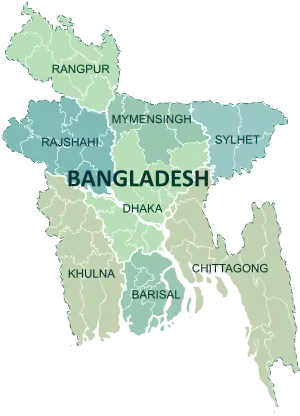Tangail
টাঙ্গাইল | |
|---|---|
 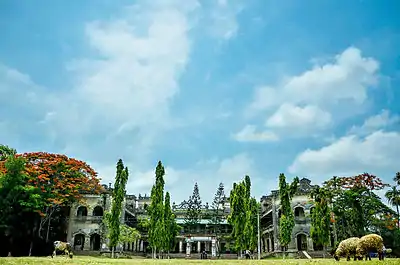    | |
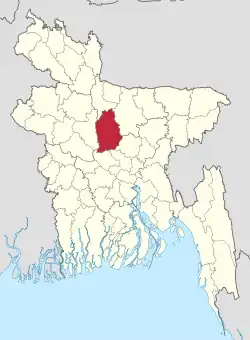 Location of Tangail District in Bangladesh | |
Expandable map of Tangail District | |
| Coordinates: 24°18′N 90°00′E / 24.30°N 90.00°E | |
| Country | |
| Division | Dhaka Division |
| Government | |
| • Deputy Commissioner | Jashim Uddin Haider |
| Area | |
| • District of Bangladesh | 3,414.28 km2 (1,318.26 sq mi) |
| • Metro | 29.52 km2 (11.40 sq mi) |
| Population (2022 census)[1] | |
| • District of Bangladesh | 4,037,608 |
| • Rank | 5th in Bangladesh |
| • Density | 1,200/km2 (3,100/sq mi) |
| Time zone | UTC+06:00 (BST) |
| Postal code | 1900 |
| HDI (2018) | 0.574[2] medium · 18th of 21 |
| Website | tangail |
Tangail (Bengali: টাঙ্গাইল জেলা, romanized: Ṭāṅgāila Jēlā) is a district (zila) in the central region of Bangladesh. In 1969, Tangail district was created by Tangail Mohokuma from its 237 square kilometers of land and 3177 square kilometers of land acquired from Mymensingh district. It is the largest district of Dhaka division by area and second largest by population (after Dhaka district). The population of Tangail zila is about 4 million and its area is 3,414.28 square kilometres (1,318.26 sq mi).[3] The main city of the district is Tangail. It is surrounded by Jamalpur District on the north, the Dhaka and Manikganj Districts on the south, the Mymensingh and Gazipur on the east, and the Sirajganj on the west.
History

Until 1969, Tangail was a part of Greater Mymensingh. In 1969 the Tangail District was established. Tangail district was created by Tangail Mohokuma from its 237 square kilometers of land and 3177 square kilometers of land acquired from Mymensingh district. The main rivers that cross the Tangail district are the Jamuna, Dhaleshwari, Jhenai, Bangshi, Louhajang, Langulia, Elongjani, Jugni, Pouli, Fotikjani and the Turag.
Administration
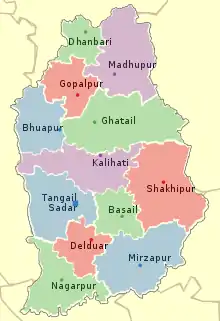
The subdivision of Tangail was established in 1870. It was turned into a district on 1 December 1969.[4] The district consists of 11 municipalities, 108 wards of these municipalities, 109 Union Parishads and 2516 villages.
Demographics
| Year | Pop. | ±% p.a. |
|---|---|---|
| 1974 | 2,077,924 | — |
| 1981 | 2,442,607 | +2.34% |
| 1991 | 3,002,428 | +2.08% |
| 2001 | 3,290,696 | +0.92% |
| 2011 | 3,605,083 | +0.92% |
| 2022 | 4,037,608 | +1.04% |
| Sources:[1][6] | ||
According to the 2022 Census of Bangladesh, Tangail District had 1,061,749 households and a population of 4,037,608, 29.2% of whom lived in urban areas. The population density was 1,183 people per km2. The literacy rate (age 7 and over) was 69.6%, compared to the national average of 74.7%.[1]
| Name | Status | Population (1991) | Population (2001) | Population (2011) |
|---|---|---|---|---|
| Basail | Upazila | 148,555 | 160,346 | 159,870 |
| Bhuapur | Upazila | 177,095 | 190,910 | 189,913 |
| Delduar | Upazila | 175,684 | 188,449 | 207,278 |
| Dhanbari | Upazila | – | – | 176,068 |
| Ghatail | Upazila | 341,376 | 371,952 | 417,939 |
| Gopalpur | Upazila | 252,747 | 274,273 | 252,331 |
| Kalihati | Upazila | 354,959 | 376,407 | 410,293 |
| Madhupur | Upazila | – | 422,889 | 296,729[lower-alpha 1] |
| Mirzapur | Upazila | 337,496 | 366,609 | 407,781 |
| Nagarpur | Upazila | 238,422 | 258,431 | 288,092 |
| Sakhipur | Upazila | 220,281 | 241,665 | 277,685 |
| Tangail Sadar | Upazila | 380,518 | 438,765 | 521,104 |
| Tangail District | Total | 3,002,428 | 3,290,696 | 3,605,083 |
Religion
| Religion | Population (1941)[7]: 96–97 | Percentage (1941) | Population (2011)[6] | Percentage (2011) |
|---|---|---|---|---|
| Islam |
956,006 | 73.83% | 3,342,596 | 92.71% |
| Hinduism |
336,081 | 25.96% | 246,237 | 6.83% |
| Christianity |
37 | 0.00% | 14,125 | 0.39% |
| Others [lower-alpha 3] | 2,679 | 0.21% | 2,125 | 0.07% |
| Total Population | 1,294,803 | 100% | 3,605,083 | 100% |
Muslims make up 92.72% and 6.83% are Hindus. There is a small population of Christians near Madhupur National Park, mainly Garo tribals.[8]
Geography
The total area of the zila is 3414.28 km2 (1318.00 sq mi), of which 497.27 km2 (192.00 sq mi) is forested. The zila lies between 24° 01′ and 24° 47′ north latitudes and between 89° 44′ and 90° 18′ east longitudes.
Climate
Tangail has a tropical climate. In winter, there is much less rainfall than in summer. According to Köppen and Geiger, this climate is classified as Aw. The temperature here averages 25.5 °C. About 1872 mm of precipitation falls annually.[9]
River system
Tangail district is flanked on the west by the Jamuna River, which is over 4 miles wide during the rainy season. The Dhaleswari, first an old channel of the Ganges and then of the Brahmaputra, cuts across the southwestern comer of the district on its powerful sweep to join the Meghna near Narayanganj. The old name of Dhaleswari was "Gajghata". It used to flow afterward by the Salimabad channel and then at last by Porabari channel.
A part of the eastern boundary of the district runs close to the Banar river. The river Bangshi flows almost down the middle of the district, branching out from the old Brahmaputra to the north from near Jamalpur. Bangshi falls into Dhaleswari near Savar, in Dhaka district. The Bangshi forms a natural barrier to the Madhupur Jungle on the Tangail side, all the way from Madhupur to Mirzapur. It is only fordable at two or three places near Basail on its way to river Meghna. Dhaleswari itself, however, takes out from the Jamuna from inside Tangail district.
Among other important rivers of the district, Lohajang is worth mentioning. It flows past the district headquarters of Tangail and is almost dead at present (in moribund condition). Other rivers are Khiru, Nanglai Nadi, Atai, Elengjani, Fatikjani, Bairan and Jhinai. The old Brahmaputra's most important offshoot is the Jhinai; striking off near Jamalpur it rejoins the Jamuna north of Sarishabari, while another branch flows past Gopalpur. Now these subsystems of rivers, viz Bangshi and Banar, and the Lohajang, Khiru, Nangtai Nadi, Atia and Jhinai are dying out because of the shift of the old Brahmaputra river from its former channel to the present Jamuna channel.
Education
The central school of Tangail is Bindu Basini Govt. Boys' High School established in 1880. Bindu Basini Govt. Girls' High School was established in 1882. These two schools were patronized and endowed by Rani Bindubasini Roy Chowdhurany and were named after her. These are nationally rewarded double shift schools.
Santosh Jahnnabi High School was established in 1870. It is the oldest school in Tangail and the second oldest in the greater Mymensingh district. Shibnath High School, Vivekananda High school, Police Lines High School, Zilla Sadar Girls' High School are some high schools in Tangail.
In 1926, the Government Saadat College was established by Wazed Ali Khan Panni, a zamindar and educationalist of Tangail. He named it after the name of his grandfather Saadat Ali Khan Panni. Govt. M. M. Ali College was established by Maulana Abdul Hamid Khan Bhasani at Kagmari (1 km from the main city) is one of the first government colleges in Bangladesh. Kumudini College was established in 1943 by Ranada Prasad Saha, philanthropist of Tangail. He named it after his mother Kumudini. Later the college was converted into Kumudini Government Women's College. He also established Bharateswari Homes in 1945 at Mirzapur. He named it after his grandmother Bharateswari Devi. Mirzapur Cadet College, the third cadet college of Bangladesh, was established in 1963. The then president of Pakistan Field Marshal Ayub Khan took initiatives to establish this cadet college.
There is a technical university named Mawlana Bhashani Science and Technology University at Santosh, Tangail. A government textile engineering college named Bangabandhu Textile Engineering College (BTEC) at Kalihati, Tangail was established in 2007. A government medical college named Sheikh Hasina Medical College, Tangail is located in Tangail. This medical college was established in 2014.
Tangail has 341 non-government high schools, 86 satellite schools, 5 government colleges, 48 non-government colleges, 3 university colleges, 1 textile engineering college, 1 medical college, 1 law college, 1 homoeopathy college, 1 textile institute,1 polytechnic institute, 1 Medical assistant training school, 2 nursing institutes, 1 police academy, 202 madrasas, 40 secondary schools (SSC),[10] 941 government primary schools, 395 non-government primary schools, 1 teachers' training school, 146 community primary schools and 1304 NGO-operated schools.
Urbanization

The urban growth rate of Tangail District is increasing as it is close to the capital of Bangladesh, Dhaka. There are 11 municipalities in Tangail District. Tangail municipality is planned to be converted into a City Corporation in next couple of years alongside 11 other old district headquarters of Bangladesh.
| Urban area | Area (km2) | No. of wards | Population |
|---|---|---|---|
| Tangail | 29.43 | 18 | 750000 |
| Gopalpur | 23.12 | 9 | 50,160 |
| Sakhipur | 27.62 | 9 | 30,028 |
| Bhuapur | 13.92 | 9 | 28,708 |
| Madhupur | 24.77 | 9 | 56,342 |
| Ghatail | 28.09 | 11 | 3,00,000 |
| Kalihati | 14.52 | 9 | 37,038 |
| Elenga | 23.24 | 9 | 55,000 |
| Basail | 9 | 13,496 | |
| Mirzapur | 8.58 | 9 | 28,602 |
| Dhanbari | 25.62 | 9 | 36,125 |
Economy
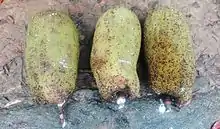
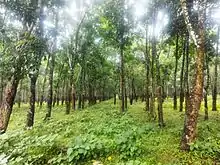
Agriculture is the main occupation of the Tangail district. About 49.53% of people are involved with agricultural activities. Its main agricultural products are paddy, potato, jute, sugarcane, sesame, linseed, wheat, mustard seed and pulse. About 3,386.53 km2 (1,307.55 sq mi) of cultivable lands are available in Tangail. The main fruit products are mangos, jackfruit, bananas, litchis, and pineapples. Other sectors, such as fisheries (446), dairies (189), industries, weaving and poultry farms (538) are developing in the Tangail district. Tangail is the home of the weavers of the world-famous "Tangail Saree".
Sarees
Tangail Saree a handloom saree made of cotton and silk thread having hand-worked butte design, all-over flowery design, or contemporary art motif is appreciated, bought, and used by women and girls of Bangladeshi and Indian origin all over the world. Tangail Saris are famous at home and abroad. Large numbers of sarees are sold on the occasion of Eid, Puja, Pahela Boishakh and wedding season between November and February. The weavers get orders from home and abroad. Tangail Sarees are produced in Tangail Sadar Upazila, Delduar Upazila and Kalihati Upazila. Pathrail in Delduar Upazila and Barabelta, Kabilapara (Porabari Union) in Sadar Upazila are famous for fine and expensive sarees.
A survey conducted in 2013 said there were 60,000 looms in Tangail. Of them, 8,305 are pit looms, 51,141 are Chittranjan looms and 892 are power looms. About 325,000 labourers, owners and traders are connected with the profession. The factories have been producing Tangail sarees worth Tk 300-Tk 20,000 apiece.[11]
Industry
There are many industries growing rapidly in Gorai Industrial Area. These include Square Group, Nasir Glassware industry, Olympic Battery, North Bengal cycle industry, and Tangail Cotton mill. There are many garments and textiles in Gorai. BSCIC Tarotia also has some industries. Alauddin Textile mill is in Tangail.
Notable people
- Rafiq Azad, poet and literary personality
- Abu Sayeed Chowdhury, President of Bangladesh
- Muhammad Abdul Bari, physicist, former Secretary General Muslim Council of Britain
- Maulana Abdul Hamid Khan Bhashani, Islamic scholar and political leader
- Dr. Abdur Razzak MP, Agricultural Scientist, Minister of Agriculture(2019-), Food (2009-2013) and a Presidium Member of Bangladesh Awami League.
- Debapriya Bhattacharya, economist
- Abul Hasan Chowdhury, politician
- Qader "Tiger" Siddiqi, politician and Mukti Bahini
- Syed Hasan Ali Chowdhury, politician
- Syed Nawab Ali Chowdhury, politician
- Abdul Halim Ghaznavi, politician
- M Farid Habib, chief of Bangladesh Navy
- Shamsul Huq, politician, first General Secretary of Awami League
- Abdur Rahman Khan, Cabinet Minister
- Ibrahim Khan, litterateur
- Abdul Mannan, politician
- Kowser ahammed,social worker
- Maj General (Rtd.) Mahmudul Hasan, politician
- Ranadaprasad Saha, businessman and philanthropist
- Fazlur Rahman Faruque, politician and Ekushey Padak award recipients
Members of tenth Jatiyo Sangsad (2014–present)
The members of the national parliament are:[12]
- Tangail-1 Seat 130: Abdur Razzak from Awami League
- Tangail-2 Seat 131: Soto Monir from Awami League
- Tangail-3 Seat 132: Amanur Rahman Khan Rana from Awami League * Present day : Ataur Rahman Khan from Awami League
- Tangail-4 Seat 133: Hasan Imam khan Sohel Hazari from Awami League
- Tangail-5 Seat 134: Md. Sanowar Hossain from Awami League
- Tangail-6 Seat 135: Ahasanul Islam Titu from Awami League
- Tangail-7 Seat 136: Md. Akabbar Hossain from Awami League; Abul-Kalam Azad Siddique, former cabinet member of national parliament
- Tangail-8 Seat 137: Joaherul Islam from Awami League
See also
- Tangail Airdrop by the Indian Army in 1971
- Tangail Airport
- Atia Mosque
- Tangail Railway Station
- Tangail Stadium
- P. C. Sorcar magician who born in Tangail & known as the father of modern Indian magic.
Notes
- ↑ Madhupur upazila was divided into Madhupur and Dhanbari upazilas
- ↑ Tangail subdivision of Mymensingh district
- ↑ Including Jainism, Christianity, Buddhism, Zoroastrianism, Judaism, Ad-Dharmis, or not stated
References
- 1 2 3 Population and Housing Census 2022: Preliminary Report. Bangladesh Bureau of Statistics. August 2022. pp. viii, 29, 38, 45. ISBN 978-984-35-2977-0.
- ↑ "Sub-national HDI - Area Database - Global Data Lab". hdi.globaldatalab.org. Retrieved 18 March 2020.
- ↑ "Tangail P-XV" (PDF). Bangladesh Bureau of Statistics. 11 June 2011. Retrieved 23 February 2016.
- ↑ D. Shamsul Haque Mia (March 1999). Education in Tangail. Tangail Forum. pp. 26–27.
- ↑ "Local Government Engineering Department". Retrieved 12 February 2014.
- 1 2 3 "Bangladesh Population and Housing Census 2011 Zila Report – Tangail" (PDF). bbs.gov.bd. Bangladesh Bureau of Statistics.
- ↑ "Census of India, 1941 Volume VI Bengal Province" (PDF).
- ↑ "Bangladesh Population & Housing Census 2011" (PDF). Retrieved 6 July 2021.
- ↑ "Climate: Tangail". climate-data.org.
- ↑ Secondary School Certificate (SSC)
- ↑ "Weaving industry hit hard by political unrest". The Independent. Dhaka. 2 March 2015.
- ↑ "List of 10th Parliament Members". Bangladesh Parliament. Retrieved 25 May 2014.
